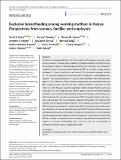| dc.contributor.author | Ickes, Scott B. | |
| dc.contributor.author | Sanders, Hannah | |
| dc.contributor.author | Denno, Donna M. | |
| dc.contributor.author | Myhre, Jennifer A. | |
| dc.contributor.author | Kinyua, Joyceline | |
| dc.contributor.author | Singa, Benson | |
| dc.contributor.author | Lemein, Hellen Sankaine | |
| dc.contributor.author | Iannotti, Lora L. | |
| dc.contributor.author | Farquhar, Carey | |
| dc.contributor.author | Walson, Judd L. | |
| dc.contributor.author | Nduati, Ruth | |
| dc.date.accessioned | 2022-03-31T14:15:56Z | |
| dc.date.available | 2022-03-31T14:15:56Z | |
| dc.date.issued | 2021-03-26 | |
| dc.identifier.citation | Ickes SB, Sanders H, Denno DM, Myhre JA, Kinyua J, Singa B, Lemein HS, Iannotti LL, Farquhar C, Walson JL, Nduati R. Exclusive breastfeeding among working mothers in Kenya: Perspectives from women, families and employers. Matern Child Nutr. 2021 Oct;17(4):e13194. doi: 10.1111/mcn.13194. Epub 2021 May 5. PMID: 33949782; PMCID: PMC8476403. | en_US |
| dc.identifier.other | DOI: 10.1111/mcn.13194 | |
| dc.identifier.other | PMCID: PMC8476403 | |
| dc.identifier.other | PMID: 33949782 | |
| dc.identifier.uri | https://repository.amref.ac.ke/handle/123456789/637 | |
| dc.description | This is an open access article under the terms of the Creative Commons Attribution License, which permits use, distribution and reproduction in any medium,
provided the original work is properly cited. | en_US |
| dc.description.abstract | Exclusive breastfeeding (EBF) for the first 6 months of life improves survival, growth
and development. In Kenya, recent legislation and policies advocate for maternity leave
and workplace support for breastfeeding and breast milk expression. We conducted a
qualitative study to describe factors influencing EBF for 6 months among mothers
employed in commercial agriculture and tourism. We interviewed employed mothers
(n = 42), alternate caregivers and employed mothers' husbands (n = 20), healthcare providers
(n = 21), daycare directors (n = 22) and commercial flower farm and hotel managers
(n = 16) in Naivasha, Kenya. Despite recognizing the recommended duration for
EBF, employed mothers describe the early cessation of EBF in preparation for their
return to work. Managers reported supporting mothers through flexible work hours
and duties. Yet, few workplaces have lactation spaces, and most considered adjusting
schedules more feasible than breastfeeding during work. Managers and healthcare providers
believed milk expression could prolong EBF but thought mothers lack experience
with pumping. The most frequently suggested interventions for improving EBF
duration were to expand schedule flexibility (100% of groups), provide on-site daycare
(80% of groups) and workplace lactation rooms (60% of groups), improve milk expression
education and increase maternity leave length (60% of groups). Returning to work
corresponds with numerous challenges including lack of proximate or on-site childcare
and low support for and experience with milk expression. These factors currently make
EBF for 6 months unattainable for most mothers in these industries. Interventions and
supports to improve breastfeeding upon return to work are recommended to
strengthen employed mothers' opportunity for EBF. | en_US |
| dc.description.sponsorship | National Institutes of Health Fogarty
International Center, Grant/Award Number:
K01TW010827 | en_US |
| dc.language.iso | en | en_US |
| dc.publisher | WILEY | en_US |
| dc.subject | Breastfeeding | en_US |
| dc.subject | Caregiving | en_US |
| dc.subject | Lactation | en_US |
| dc.subject | Low-income countries | en_US |
| dc.subject | Policy | en_US |
| dc.subject | Qualitative methods | en_US |
| dc.subject | Social factors | en_US |
| dc.title | Exclusive Breastfeeding among Working Mothers in Kenya: Perspectives from Women, Families and Employers | en_US |
| dc.type | Article, Journal | en_US |

